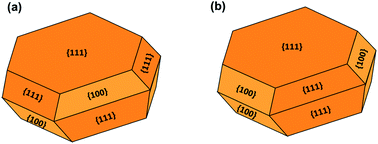The influence of iodide on the solution-phase growth of Cu microplates: a multi-scale theoretical analysis from first principles†
Abstract
We use first-principles density functional theory (DFT) to quantify the role of iodide in the solution-phase growth of Cu microplates. Our calculations show that a Cu adatom binds more strongly to hcp hollow sites than fcc hollow sites on iodine-covered Cu(111) – the basal facet of two-dimensional (2D) Cu plates. This feature promotes the formation of stacking faults during seed and plate which, in turn, promotes 2D growth. We also found that iodine adsorption leads to strong Cu atom binding and prohibitively slow diffusion of Cu atoms on Cu(100) – a feature that promotes Cu atom accumulation on the {100} site facets of a growing 2D plate. Incorporating these insights into analog experiments, in which we initiated the growth of Cu plates from small seeds consisting of magnetic spheres, we confirmed that two or more stacking faults are required for lateral plate growth, consistent with prior studies. Moreover, plates can take on a variety of shapes during growth: from triangular and truncated triangular to round and hexagonal – consistent with experiment. Using absorbing Markov chain calculations, we assessed the propensity for 2D vs. 3D kinetic growth of the plates. At experimental temperatures, we predict plates can grow to achieve lateral dimensions in the 1–10 micron range, as observed in experiments.

- This article is part of the themed collection: Understanding Crystallisation


 Please wait while we load your content...
Please wait while we load your content...
